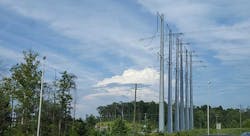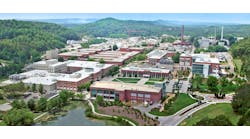Data centers are once again stirring debate in Prince William County in Northern Virginia, where the supervisors voted this week to study opening new areas for data center development.
The study will examine whether to allow data centers on 800 acres of agricultural land in Manassas, and is tied to a broader initiative to update the county’s comprehensive plan to expand data center development.
The supervisors approved the study by a 5-3 party-line vote, with the board’s Democrats supporting the measure. More than 70 area residents spoke at the meeting, which ran into the early morning hours, and was preceded by a press conference in which six conservation groups spoke out in opposition to additional data center expansion. Public comment at the meeting was evenly split between supporters and opponents of the study, according to local media accounts.
Data center development in Prince William has accelerated in recent years amid strong demand for additional cloud computing capacity in Northern Virginia. As development parcels grow scarce near the regional data center hub in Ashburn in Loudoun County, developers have shifted their focus to Prince William County, establishing a growing cloud cluster near Manassas. This has boosted property values, with recent transactions valuing data center development sites at nearly $1 million an acre.
That trend has prompted a group of homeowners along Pageland Lane in Manassas to band together to propose the Prince William Digital Gateway, a data center district that could support up to 21 million square feet of new data center development. The properties are adjacent to a high-capacity power line from Dominion Energy, making the area desirable for data center site selection.
At issue is whether expanding data centers would spoil the character of a rural area of the county, or whether existing development and the power lines have already made the area a commercial corridor.
Neighbor vs Neighbor, Rather Than Public vs. Developer
At DCF we’ve been tracking public controversies surrounding data center development in recent years, examining the “NIMBY Challenge” (Not In My Back Yard) as cloud growth makes data centers a more common element of rural and suburban communities. Our 2018 industry forecast projected that these disputes would make more headlines that year, a prediction that turned out to be premature.
But public scrutiny of large data center projects is now commonplace, as residents pay close attention to their impact on the environment, public resources, and quality of life. The interesting wrinkle in the current Prince William debate is that data center development is being advanced by residents and landowners familiar with the benefits of cloud real estate.
“This growing industry will provide millions of dollars in tax revenue annually, reduce tax burden for residents, bring better-paying jobs to PWC, fund our schools, and so much more,” the Prince William Digital Gateway web site says, advancing economic arguments usually made by the industry or economic development teams.
At its Tuesday meeting, the Prince William Board of Supervisors approved a study of whether the county comprehensive plan should be amended to allow data center development as an approved land use for parcels totaling 800 acres along Pageland Lane.
Here’s a sampling of media coverage of Tuesday’s hearing from local media:
- Supervisors OK Study of 800-Acre Data Center Campuses Near Manassas Battlefield (Prince William Times)
- Data Centers Could Be Coming to Pageland (Inside Nova)
To get a sense of the arguments and sentiments, here are the web sites for groups on both sides of the development debate:
- Prince William Digital Gateway: Pageland Lane homeowners group.
- Coalition to Protect Prince William County: Community group opposing data center development.
Background
Northern Virginia is a strategic location for cloud computing platforms, and is experiencing a huge burst in data center development due in part to the impact of the COVID-19 pandemic, which is accelerating cloud adoption as society shifts to digital platforms to support socially-distanced work, education and commerce. Google and Microsoft are adding cloud capacity in Northern Virginia, which is also home to Amazon Web Services’ massive US-East region.
Much of this new development has focused on sites in Prince William County, which has seen new data center campuses for Amazon Web Services, CloudHQ, Iron Mountain, and QTS Data Centers, with projects under development by Digital Realty, STACK Infrastructure, and Yondr Group among others.
Prince William has actively marketed itself as a destination for data center development. In 2016, the county created a Data Center Opportunity Zone Overlay District, aligning development with planning priorities and properties with supporting infrastructure.
The current debate focuses on whether the overlay district should be expanded, prompting a larger discussion of sentiments about data center development, pitting the economic benefits of data centers with some residents’ desire to maintain the rural character of the region. A similar debate has occurred in Loudoun County, which houses the world’s largest concentration of data centers as well as dozens of farms and wineries.
In Prince William, sales of vacant land within the county’s data center overlay district ranged from $441,000 per acre to $711,000 per acre in 2020, county officials said, helping boost assessments of vacant land in the county by nearly 15 percent. Assessments of vacant land in areas where data centers are allowed by-right rose 103 percent in 2020.
The industry’s growing profile in Manassas is also of keen interest to the Board of Supervisors, which in April adopted a fiscal year 2022 budget that raised the tax rate on data center equipment to $1.50 per $100 of assessed value. The board previously debated (and later dropped) a sharp increase in taxes on data center equipment in 2018, and then in 2020 passed a more modest 10-cent boost to $1.35 per $100 of assessed value.






